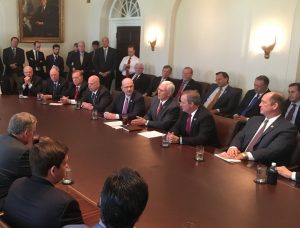As the fates would have it, a Politburo-style maneuver failed.
There’s a rude old joke about the disgruntled office worker complaining that he feels like a mushroom. “My bosses usually leave me in the dark, and then they feed me a bunch of sh-t.”
No one likes to be kept out of the loop while consequential decisions that will affect everyone are being made. The rueful remark is a reminder of why the attempt by the Senate leadership to draft health care legislation in secret was so troubling and—in a basic sense—un-American. Healthcare is approaching 20% of the entire American economy. Just thirteen Republican Senators—incredibly, without even one woman among them—drafted the legislation (the misnamed “Better Care Reconciliation Act”) and then sprang it on the rest of us in what was supposed to be an early vote. Senate Majority Leader Mitch McConnell was clearly hoping that the secrecy that shut out the media and most members of his own conference would make passage easier. The press would be blindsided. There would be little time for anyone to read the bill or debate it. There would be no committee mark-ups or hearings, no expert or stakeholder testimony. He knew that some legislators will put party first and sometimes vote on bills they do not understand. As the fates would have it, a Politburo-style maneuver failed.
Some members of the Senate GOP complained of being blindsided. A few others didn’t like the short timetable. So McConnell had no choice but to postpone the vote until after the July 4 break.
There is reason to take heart in the old and honorable American expectation that representatives at all levels of government should do their work with the lights on and the doors open.
So the bill has been dragged into the light where it belongs. Legislating is meant to luxuriate in communication, doubly so in an open society. Now the press is reporting and assessing. The public is weighing in. And interested Americans can consider the consequences of the planned rollbacks and tax breaks that made the proposed legislation so regressive. For the moment, the legislative process has defaulted to a norm of openness and public discussion. We get to actually see the car before we buy it.
There is reason to take heart in the old and honorable American expectation that representatives at all levels of government should do their work with the lights on and the doors open. States have “sunshine laws” that require agencies to publicize their decision-making processes. We have a Freedom of Information Act that sometimes allows close inspection of bureaucratic paper trails. We have a non-partisan Congressional Budget Office that will provide an effects-oriented report. And, of course, we rightly celebrate a First Amendment that gives reporters and citizens the right to ask tough questions to their representatives and register complaints.
It is true that most legislation in the United States is written by small committees of legislators, often with lobbyists submitting drafts as well. And it is equally true that most Americans are not interested or too distracted to notice consequential law-making that will change their lives. But the process is grievously sabotaged if legislators who have pledged to uphold the Constitution usurp its intent by working in secret. Hearings are usually the open window in the process. When even those are curtailed we have good reason to question the honor of the leaders involved.
